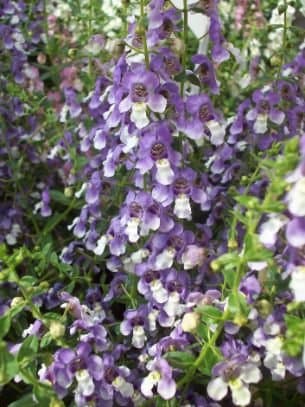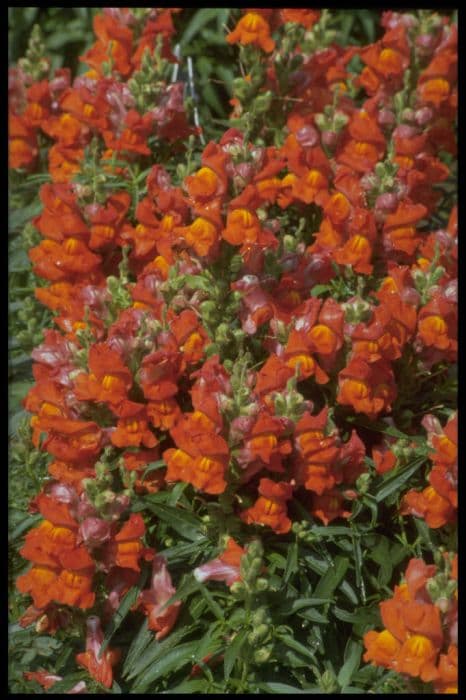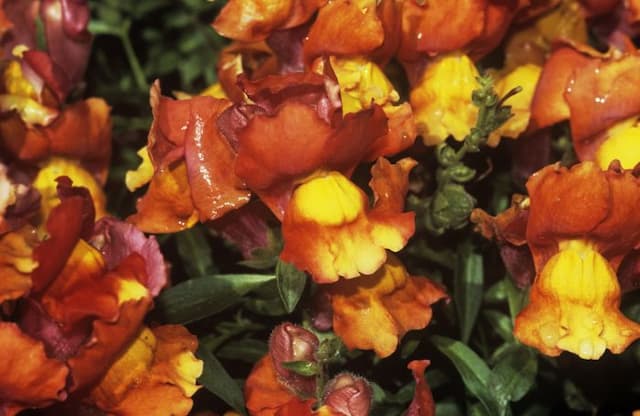Soft snapdragon Antirrhinum molle

ABOUT
The plant known commonly as the soft snapdragon features a distinctive appearance. Its stems are sprawled out, forming a subdued yet bushy aspect. The leaves that clothe the stems are gentle to the touch with a velvety texture, which the name soft snapdragon alludes to their plush softness. These leaves are typically a refreshing green shade, enhancing the plant's overall lush look. The most striking characteristic of the soft snapdragon is its flowers: they are colorful, expressive, and full of personality. Blossoming in a variation of hues which can include pinks, purples, and whites, the flowers have an irregular, two-lipped shape that resembles the open mouth of a dragon—hence the name "snapdragon." In full bloom, the petals may display a gradient of color, with a deeper shade at the center that fades into a lighter tone at the fringe. This plant often gives off a gentle aroma from its flowers, which can attract various pollinators to dance around its tendrils while bringing a subtle fragrance to a garden setting. The overall impression of the soft snapdragon is one of a charming and somewhat whimsical plant, with a soft texture and vibrant flowers that can bring a playful touch to any garden or floral landscape where it spreads its delicate branches.
About this plant
 Names
NamesFamily
Plantaginaceae
Synonyms
Soft Snapdragon, Velvety Snapdragon, Twinny Appleblossom
Common names
Antirrhinum molle
 Toxicity
ToxicityTo humans
The plant Antirrhinum molle, commonly known as the soft snapdragon, has limited information available regarding its toxicity to humans. Most members of the snapdragon family are not considered highly toxic, but they may contain compounds that can cause mild gastrointestinal upset if ingested in large quantities. It is always wise to exercise caution and not consume any part of ornamental plants without proper knowledge of their edibility and potential effects. If someone ingests part of the soft snapdragon and experiences symptoms such as nausea, vomiting, or stomach pain, seek medical attention.
To pets
The plant Antirrhinum molle, commonly known as the soft snapdragon, is not well-documented for its toxicity in pets such as dogs and cats. In general, snapdragons are not known to be highly toxic to pets. However, as with any plant not intended for pet consumption, the ingestion of soft snapdragon might result in mild gastrointestinal upset, characterized by symptoms such as vomiting or diarrhea. If you suspect your pet has ingested part of this plant and is showing these symptoms, it is advisable to contact a veterinarian.
 Characteristics
CharacteristicsLife cycle
Perennials
Foliage type
Evergreen
Color of leaves
Green
Flower color
Yellow
Height
1 foot [30 cm]
Spread
1 foot [30 cm]
Plant type
Herb
Hardiness zones
8
Native area
Mediterranean
Benefits
 General Benefits
General Benefits- Ornamental Value: Antirrhinum molle, commonly known as the velvet snapdragon, has aesthetically pleasing flowers and foliage that add visual interest to gardens and landscapes.
- Pollinator Attraction: The plant is known to attract beneficial pollinators such as bees and butterflies, supporting local ecosystems.
- Drought Tolerance: Velvet snapdragons are fairly drought-tolerant once established, making them suitable for xeriscaping and low-water gardens.
- Easy to Grow: This species is relatively easy to cultivate, requiring minimal care, which makes it a good choice for novice gardeners.
- Versatility: Can be used in a variety of garden settings, including borders, flower beds, and containers, due to its compact size and colorful blooms.
- Seasonal Interest: Provides seasonal blooms that can add color throughout the growing season, depending on the climate and environment.
 Medical Properties
Medical PropertiesThis plant is not used for medical purposes.
 Air-purifying Qualities
Air-purifying QualitiesThis plant is not specifically known for air purifying qualities.
 Other Uses
Other Uses- As a companion plant in gardens, Antirrhinum molle (commonly known as soft snapdragon) can provide benefits to vegetables and other plants by attracting beneficial insects such as pollinators or predatory insects that help keep pest populations in check.
- Soft snapdragons can be employed in education for children to learn about plant biology and pollination, given their interactive 'mouth' structure which can be gently squeezed to imitate a snapping action.
- These flowers can be used in floral arrangements to add height and texture, where their unique flower shape stands out among other blooms.
- Due to its drought-tolerant nature, Antirrhinum molle can be utilized in xeriscaping and low-water garden designs, helping to conserve water while still providing aesthetic value.
- The plant can be used in natural dye production, where different parts of the plant like petals or leaves might yield dyes for fabrics and art projects.
- Soft snapdragon can be utilized in butterfly gardens to attract various species of butterflies and contribute to their habitat diversity and foraging needs.
- Crafted into a living plant sculpture, the sturdy stems of Antirrhinum molle can be shaped and maintained as a topiary in ornamental gardens.
- As a cut flower, Antirrhinum molle's blooms may continue to open after being cut, making it an interesting plant for science experiments about plant physiology and hydration.
- Growing Antirrhinum molle can serve as a natural marker of the seasons, as its blooming period indicates the onset of spring, which can aid in planning other gardening activities accordingly.
- In photography and painting, the intricate form and range of colors of Antirrhinum molle flowers provide a rich subject matter for artists seeking to capture natural beauty.
Interesting Facts
 Feng Shui
Feng ShuiThe plant Snapdragons is not used in Feng Shui practice.
 Zodiac Sign Compitability
Zodiac Sign CompitabilityThe plant Snapdragons is not used in astrology practice.
 Plant Symbolism
Plant Symbolism- Graciousness: Antirrhinum molle, commonly known as "Dwarf Snapdragon," often symbolizes graciousness due to its delicate appearance and the gentle way it sways with the breeze.
- Deception: Snapdragons have a closed mouth appearance that is said to represent a secretive nature or the act of keeping something hidden, much like the way their petals conceal the inner flower parts.
- Strength: Despite its soft appearance, the Dwarf Snapdragon is known for its hardiness and resilience, making it a symbol of strength and the ability to overcome adversity.
- Protection: In folklore, Snapdragons were thought to offer protection. Carrying them was believed to guard individuals against deceit and falsehood.
 Water
WaterTo water Groote’s snappingdragon, it's best to allow the soil to dry slightly between waterings. They prefer consistent moisture but do not like to be waterlogged. Typically, watering once a week with one to two gallons of water should suffice, depending on the size of the plant and the environmental conditions. During hot, dry periods, this species might require more frequent watering; checking the top inch of the soil for dryness can guide you. Ensure water is applied directly to the soil and not over the foliage to minimize disease risk.
 Light
LightGroote’s snappingdragon thrives in full sun to partial shade. It is ideal to place them in a spot where they receive at least six hours of direct sunlight a day. They can tolerate some light shade, especially in regions with very hot summers, but too much shade may result in fewer flowers and leggy growth.
 Temperature
TemperatureGroote’s snappingdragon does well in a wide range of temperatures but prefers moderate conditions. They can survive in temperatures as low as 40 degrees Fahrenheit and as high as 90 degrees Fahrenheit. Ideal growing temperatures for this plant are between 60 and 75 degrees Fahrenheit.
 Pruning
PruningPruning Groote’s snappingdragon is important for encouraging bushier growth and more blooms. Deadhead spent flowers regularly to promote continuous flowering. Perform a more thorough pruning in late winter or early spring, cutting back the plant to about a third of its size to rejuvenate it and encourage new growth.
 Cleaning
CleaningAs needed
 Soil
SoilThe soft snapdragon (Antirrhinum molle) thrives in loamy, well-draining soil with a pH of 6.2 to 7.0. A balanced mix of two parts loam, one part peat, and one part sand or perlite can provide the ideal growing conditions.
 Repotting
RepottingSoft snapdragons should be repotted every 1-2 years during the spring. This routine supports their growth by replenishing nutrients and allowing room for roots to expand.
 Humidity & Misting
Humidity & MistingSoft snapdragon prefers moderate humidity levels. Aim for a range of 40-50% to maintain optimal growth conditions without encouraging fungal diseases.
 Suitable locations
Suitable locationsIndoor
Place soft snapdragon in bright, indirect light and ensure good air circulation.
Outdoor
Plant in full sun to partial shade with shelter from strong winds.
Hardiness zone
7-10 USDA
 Life cycle
Life cycleThe life of Antirrhinum molle, commonly known as the Soft Snapdragon, begins with seed germination, typically in early spring, when soil temperatures are conducive to growth. Once the seeds sprout, the seedlings will establish themselves and develop a root system and foliage through the vegetative growth stage. As the plant matures, it enters the flowering stage, usually in late spring to summer, where it produces characteristic snapdragon-like flowers that are pollinated by insects. Following pollination, the flowers develop into fruit capsules containing seeds, and as the capsules dry, they release the seeds, thus completing the reproductive stage of the cycle. In the absence of perennial growth, the plant will die after seed dispersal, making it an annual or biennial species. However, if it is grown in favorable conditions, it may survive as a perennial, regrowing from the base the following season.
 Propogation
PropogationPropogation time
Spring-early summer
Propogation: The common name for Antirrhinum molle is Soft Snapdragon. When propagating Soft Snapdragon, the most popular method is through sowing seeds. The ideal time to sow seeds is during spring, after the last frost has passed, ensuring that seedlings are not exposed to freezing temperatures that can hinder their growth. To propagate, seeds are lightly pressed onto the surface of a well-draining soil mix and kept moist but not waterlogged. They require light to germinate, so they should not be buried deep within the soil. It typically takes 10 to 20 days for germination to occur at a temperature of around 70 to 75 degrees Fahrenheit (21 to 24 degrees Celsius). Once seedlings have developed a couple of true leaves, they can be transplanted into individual pots or directly into the garden, maintaining appropriate spacing for growth.









